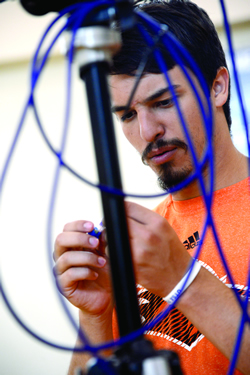
Daniel Portillo, a sophomore mechanical engineering student and kicker for the Roadrunner football team, tries out a portable tracking device system that tells a kicker how his body, eyes, and positioning affects his kick.
Engineering football excellence
In 2013, a team of UTSA College of Engineering students, led by Yusheng Feng, director of the Center for Simulation Visualization and Real-Time Prediction (SiViRT), worked with the Roadrunner football team to develop a football kicking simulator. The full-scale, indoor simulator (FKS 1.0) aimed to improve a kicker’s performance by providing real-time data when the ball was kicked toward a display screen. Pressure sensors determined the trajectory of the ball from the collected data, and displayed the predicted flight path of the ball within a virtual world. The virtual world simulated a real world environment by using a 3D display and playing the sound of a crowd cheering.

Daniel Portillo, sophomore mechanical engineering student and kicker for the Roadrunner football team, helps set up one of the eight motion capture cameras that collect data from the kicker's kick.
As advanced as it was, some major drawbacks to the system were cost and space restriction. The kicker had to have a dedicated room at his disposal. But now, two years later, two engineering students, Roadrunner football kicker Daniel Portillo and punter Yannis Routsas, are working with a smaller and more portable tracking device system (FSK 2.0) that could change the way football kickers, from the middle school level all the way up to the pros, train. Moreover, the goals are augmented with mitigation of injury risk by analyzing body motion using biomechanics and kinesiology principles, as well as studying eye-body motion coordination.
“The current system consists of a multi-dimensional sensor system to track body motion, eye movement, and ball velocity,” said Portillo, a sophomore mechanical engineering student. “The system is designed to optimize kicking performance and reduce the chance of injury. What we are looking for is basically the best way to kick.”
Just as golfers and baseball players all have different swings to hit the ball, a kicker also has a ‘swing’. In the FSK 2.0 system, approximately 40 reflective markers are attached to the kicker’s body. These markers are tracked by eight motion capture cameras. This motion tracking technology allows 3D plotting of body motion at each key point of the kicking movement. Based on that information, Saki Oyama, an assistant professor in the Department of Kinesiology, Health, and Nutrition, uses biomechanical equations and algorithms to calculate various movement parameters.
“We can calculate joint angles and velocities,” said Oyama. “We can describe how the joints are moving and how fast the joints are moving. We will use that information to identify the key parameters for performance and injury development.”
The data collected from the sensors and cameras are combined with information gathered from the eye tracking software in the glasses worn by the kicker as well as the data gathered from a miniature motion sensor placed in the top of the football. When all the data is integrated, these engineering student athletes hope they can break the code to what makes a perfect kick.

Saki Oyama, an assistant professor in the Department of Kinesiology, Health, and Nutrition, uses biomechanical equations and algorithms to calculate various movement parameters associated with the portable tracking device system.
“There are not many places where you can do two things you love at the same time, and UTSA is one of them,” said Routsas, a freshman mechanical engineering student. “Combining football and engineering together, this is a once-in-a-lifetime opportunity.”
According to Feng, director of SiViRT and professor in the Department of Mechanical Engineering, once this project is completed, the FKS 2.0 can be deployed to the field for real-time data collection.
“With mathematical modeling and software support, we hope to provide insight to both coaches and players with quantified information to design optimal training protocols,” Feng said.
Feng says that as a professor, there is nothing that makes him happier than to nurture students and see them grow while working on a fun and meaningful project such as this one.
“This is a particularly exciting project since both football kickers on the current Roadrunner football team, Daniel Portillo and Yannis Routsas, are also engineering students who invented the ball tracking and impact location detection devices,” he said. “I can see from their eyes how excited they are when they realized that their engineering creativity can be directly applied to the sport they love.”
– Story and photos By Deborah Silliman/College of Engineering

